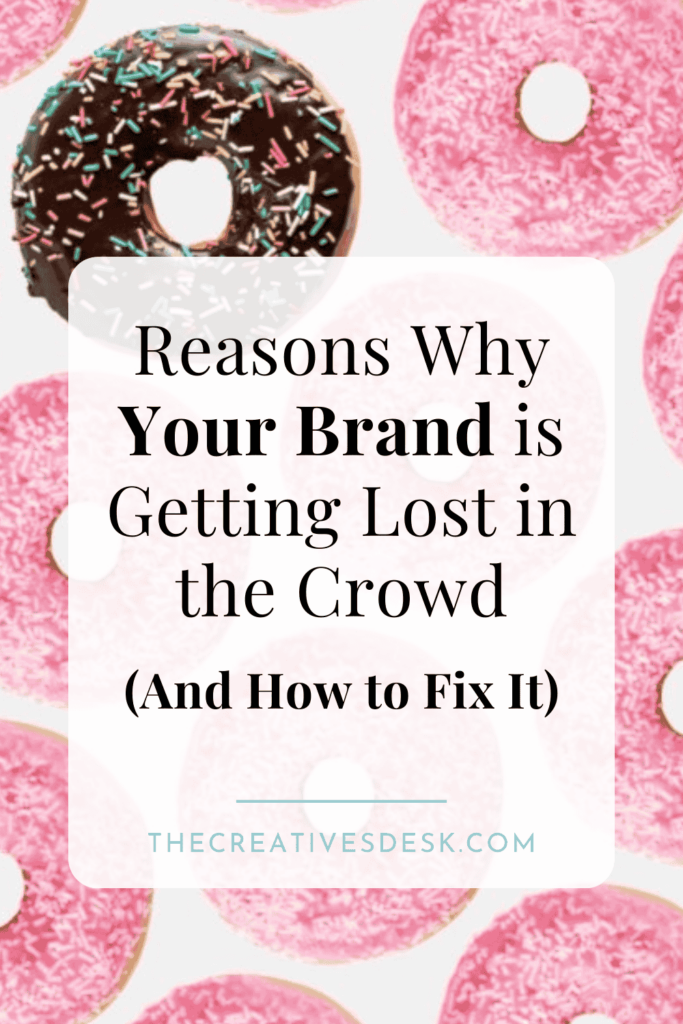

Let’s face it: just having an amazing product or service is not enough.
I learned this the hard way back in 2018 when I decided to turn my art hobby into a business. At the time, I thought having beautiful work would be enough to attract customers. I poured my heart into creating art prints to sell, but I struggled to build an audience.
Looking back, I can see now that my offers just blended into the sea of other people’s art. And this was because I didn’t have a consistent look or feel and I didn’t even a target audience. In short, I had no clearly defined brand.
So take on my lesson learned: a strong brand is essential if you want to stand out and connect with the right people.
But why do some brands struggle to make an impact while others seem to shine?
Understanding what makes successful brands stand out and nailing down the basics of good positioning will give you the know-how you need to really set your business apart.
Keep reading to explore the reasons why your brand might not stand out enough, along with actionable strategies to help you turn things around.
Having a strong brand identity is absolutely essential if you want your business to stand out.
Without a well-defined brand identity, your business risks blending into the background or worse, being completely forgettable (yikes, right!).
One of the telltale signs of a weak brand identity is not having a recognizable brand voice. For example, sounding professional on some posts and casual and carefree in others.
Also having no clear core message is another indication of a poor brand identity. It just makes it hard for customers to understand what you’re all about – or why they should care!
Define your brand’s identity by answering these key questions:
Once you’ve defined these aspects, you can start applying this consistently across all platforms, from your social media and website to packaging and marketing materials.
Let’s face it – people make snap judgments based on appearances, and your brand’s visuals are often the first impression customers get.
There’s a reason the phrase, “Don’t judge a book by its cover” is often bandied around. It’s because people can’t help but judge something by the way it looks.
If your designs look outdated, unpolished, or inconsistent, you could be losing potential business without even realizing it.
Low-quality visuals can make you seem less credible, even if your products or services are top-notch. A cohesive, professional look not only catches attention but also builds trust with your audience.
Invest in professional graphic design, whether by hiring a freelancer, bringing someone in-house, or doing it yourself in Canva and using sets of pre-designed social media templates and customizable lead magnet templates for example.
Either way, ensure that your visuals align with your brand identity and that they appeal to your target audience. Consistency is key here, so stick to a unified palette of colors, fonts, and imagery across all platforms to strengthen recognition.
Ever felt confused when a brand’s messaging doesn’t match across platforms? Maybe their Instagram is playful and fun, but their website feels formal and stuffy.
This kind of inconsistency makes it hard for customers to trust your business, as it feels like they’re dealing with two completely different entities.
Without clear and unified messaging, your audience may struggle to understand what your brand stands for, which can hurt your ability to build loyalty.
Part of your brand-building strategy should be to develop a consistent brand voice. Your brand voice outlines your tone, key messages, and the language that you use.
Make sure your team understands and communicates in this style across all your channels – from customer service emails to social media posts.
When your brand voice is clear and cohesive, it builds trust and makes it easier for people to connect with your business.
While digital marketing dominates, print materials like posters, brochures, and business cards still play a crucial role in building brand recognition.
These tangible touchpoints can make a lasting impression, especially in offline settings like events or local campaigns.
If your brand relies solely on digital assets, you could be missing opportunities to connect with your audience in a memorable way.
Ensure you incorporate print materials to complement your digital strategy. For example, using business cards for networking events, and distributing flyers or brochures in strategic locations for targeting local audiences.
Professional printing services, like an online printer, can help you create high-quality materials that enhance your brand.
Standing out in a sea of competition starts with having a solid unique selling proposition (USP). If your business doesn’t clearly communicate what makes it special, customers will struggle to see why they should choose you over someone else.
Without a strong USP, your brand can end up sounding generic, leaving your audience uninterested and uninspired. A well-defined USP not only helps you differentiate yourself but also allows you to focus your messaging in a way that resonates deeply with your target audience.
Identify what makes your services or products unique and how they meet your customers’ needs. This could be anything from superior quality and sustainable practices to exceptional customer service or innovative features.
Once you’ve nailed down your USP, emphasize it in your marketing campaigns to position your brand as the clear choice.
When you try to appeal to everyone, you end up connecting with no one. Being too broad in your messaging makes it hard for any specific group to feel truly seen or understood.
Without a clear understanding of your target audience, your efforts can feel scattered and ineffective. Instead, focusing on a specific group of people allows you to create messaging and offers that genuinely resonate with them.
Define your target audience by creating a detailed buyer persona. Include their interests, values, pain points, and demographics, such as age, gender, and income.
Once you know who they are, tailor your messaging, products, and services to meet their unique needs and wants.
A lackluster or outdated online presence can make your business seem irrelevant or unreliable. Your website and social media platforms are often the first places potential customers go to learn more about you.
If they find a clunky website or dormant social media accounts, they will question the value of your offers. A strong online presence shows that your brand is active, engaged, and ready to serve its audience.
Optimize your website to be mobile-friendly, visually appealing, and fast-loading. Include clear calls to action that guide your customers toward your offers.
Actively engage on social media by posting consistently, interacting with your audience, and sharing content that reflects your brand’s values.
Plus, I believe that investing in SEO is also essential; as high-ranking search engine results help potential customers discover your brand.
Marketing your business isn’t a one-and-done effort – it’s a consistent push to get your message in front of your audience.
Many businesses make the mistake of pulling the plug too early, whether it’s cutting short an ad campaign, only sending a handful of emails, or not printing enough flyers.
The result? Minimal impact and a whole bunch of missed opportunities.
Don’t worry about someone seeing the same promotions multiple times – it’s often a good thing! It’s familiarity that leads to trust and engagement.
Make sure you’re remarketing and retargeting (these are two different things). Remarketing is all about repetition and hammering your message home so that those who ignored it the first time may pay attention the second or third time. Retargeting is all about trying new audiences and angles – you may find that small tweaks increase engagement and build more leads.
It’s important to know that marketing momentum really does take time, and it’s not uncommon for campaigns to gain traction only after several weeks. The key is to keep at it!
Your customers’ experience can make or break your business. If customers feel undervalued or frustrated at any stage of their journey, they’re unlikely to return – and even less likely to recommend you to others.
On the flip side, a great customer experience can turn one-time buyers into lifelong advocates who rave about your brand.
Make sure you prioritize customer service by responding promptly to inquiries and resolving any issues effectively.
Also, take the time to gather feedback through reviews or surveys to identify pain points and areas for improvement.
I also recommend that when possible you personalize interactions by offering tailored recommendations and communicating 1-on-1 with individual customers. Small, thoughtful touches like that can go a long way in creating a memorable and enjoyable experience.

People don’t just buy products or services; they buy into the stories behind them.
If your brand doesn’t share its journey, mission, or values, you’re missing out on a powerful way to connect with your audience.
A compelling story can transform your brand from a faceless entity into something relatable and human, making it easier for customers to form an emotional bond.
Share your brand’s journey, mission, why you’re passionate about what you do, and the impact you aim to create.
Highlight customer success stories and include behind-the-scenes content to give people a glimpse into the heart of your business.
Whether it’s a post about the challenges you overcame or a video showcasing your team in action, storytelling helps your audience see the human side of your brand.
Trust is the foundation of any strong brand. Without it, even the best products or services can fail to gain traction.
Negative reviews, a lack of transparency, or limited social proof can all chip away at your credibility, leaving potential customers hesitant to engage with your business.
Showcase customer reviews, testimonials, and case studies to demonstrate your value and reliability.
Be transparent about your pricing and policies to build trust and set clear expectations.
Above all, consistently deliver on your promises – whether it’s quality, customer service, or meeting deadlines. As reliability and authenticity are the key to building long-term trust with your audience.
The business world moves quickly, and brands that resist adapting to new trends risk being left behind.
While staying true to your identity is important, ignoring shifts in customer behavior, technology, or industry trends can make your brand feel outdated or out of touch.
Keep an eye on marketing trends and evolving customer preferences to stay competitive.
Experiment with new platforms or tools, like AI-driven personalization or video marketing, to keep your brand fresh and relevant.
Adapt without losing sight of your core identity, and find ways to incorporate trends that align with your brand values and audience needs.
Building a brand that stands out might feel like a big task, but it doesn’t have to be overwhelming. With some intentional tweaks and a solid plan, you’ll be on your way to creating a business that’s memorable, impactful, and totally you.
Here are the key takeaways to keep in mind:
You’ve got what it takes to make your brand shine – it’s all about being intentional and showing up as your best self. Let’s go make that magic happen!

Share to…

Sign up to get 10 free Canva templates for your social media.
Created with solopreneurs in mind, these templates offer a variety of content types to help boost your online presence!